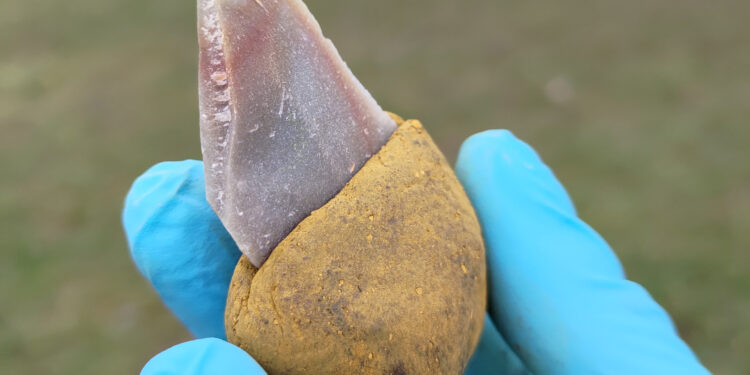The stone tool was glued into a handle of liquid bitumen with 55% ocher. It is no longer sticky and can be handled easily. Credit: Patrick Schmidt
Neanderthals created stone tools held together by a multi-component adhesive, a team of scientists has discovered. His findings, which constitute the first evidence of a complex adhesive in Europe, suggest that these predecessors of modern humans had a higher level of cognition and cultural development than previously thought.
The work, reported in the journal Scientists progressincluded researchers from New York University, the University of Tübingen and the National Museums in Berlin.
“These surprisingly well-preserved tools present a technical solution broadly similar to examples of tools made by early modern humans in Africa, but the exact recipe reflects a Neanderthal ‘version,’ which is the production of handles for hand-held tools,” says Radu Iovita. , associate professor at the Center for the Study of Human Origins at New York University.
The research team, led by Patrick Schmidt from the Ancient Prehistory and Quaternary Ecology section of the University of Tübingen and Ewa Dutkiewicz from the Museum of Prehistory and Ancient History at the National Museums in Berlin, re-examined previous discoveries from Le Moustier, an archaeological site in France discovered at the beginning of the 20th century.
The Moustier stone tools, used by Neanderthals in the Mousterian Middle Paleolithic between 120,000 and 40,000 years ago, are preserved in the collection of the Museum of Prehistory and Ancient History in Berlin and had not been examined in detail previously. The tools were rediscovered during an internal review of the collection and their scientific value was recognized.
“The items had been individually wrapped and untouched since the 1960s,” Dutkiewicz says. “As a result, the adhering remains of organic substances were very well preserved.”
Micrographs showing traces of wear on a tool used by Neanderthals in the Middle Paleolithic. The locations of the micrographs on the artifact are shown in the drawing (top left) in red. a) Polish or shine the working edge of the tool handle. b) Polish under the dye stains in the adhesive covered area. c) Ridge between concave surfaces formed by the removal of pieces of stone that have been removed rather than naturally worn. d) Blunt or worn edge in the grip area covered with adhesive. A comparison of (c) and (d) indicates that the worn part is in the area covered by the designed adhesive handle. Images are displayed in microns. Credit: Drawing by D. Greinert, Staatliche Museen zu Berlin.
Researchers found traces of a mixture of ocher and bitumen on several stone tools, such as scrapers, flakes and blades. Ocher is a natural earth pigment; Bitumen is a component of asphalt and can be produced from crude oil, but it also occurs naturally in the ground.
“We were surprised that the oche content was above 50%,” says Schmidt. “Indeed, air-dried bitumen can be used as is as an adhesive, but loses its adhesive properties when such large proportions of ocher are added.”
He and his team examined these materials in tensile tests (used to determine strength) and other measurements.
“The situation was different when we used liquid bitumen, which is not really suitable for bonding. If you add 55% ocher, a malleable mass is formed,” explains Schmidt.
The mixture was just sticky enough for a stone tool to get stuck in it, but without sticking to the hands, making it a suitable material for a handle.
Indeed, a microscopic examination of the traces of wear on these stone tools revealed that the adhesives on Le Moustier’s tools were used in this way.
Liquid bitumen and ocher pigmented earth before mixing. Credit: Patrick Schmidt
“The tools showed two types of microscopic wear: one is the typical polishing of sharp edges that is usually caused by working with other materials,” explains Iovita, who carried out this analysis. “The other is a glossy varnish distributed over the entire presumed hand-held part, but not elsewhere, which we interpreted as the result of abrasion of the ocher due to movement of the tool in the handle.”
The use of adhesives containing multiple components, including various sticky substances such as tree resins and ocher, was previously known among early modern humans, Homo sapiens, in Africa, but not among earlier Neanderthals in Europe.
Overall, the development of adhesives and their use in tool making is considered some of the best material evidence for the cultural evolution and cognitive abilities of early humans.
“Compound adhesives are considered one of the earliest expressions of modern cognitive processes still active today,” says Schmidt.
In the Moustier region, ochres and bitumens had to be collected remotely, which required a lot of effort, planning and a targeted approach, the authors note.
“Given the general context of the findings, we assume that this adhesive material was made by Neanderthals,” concludes Dutkiewicz.
“Our study shows that early Homo sapiens in Africa and Neanderthals in Europe had similar thought patterns,” adds Schmidt. “Their adhesive technologies are equally important to our understanding of human evolution.”
More information:
Patrick Schmidt, Ocher-based compound adhesives from the Mousterian-type site document complex cognition and high investment, Scientists progress (2024). DOI: 10.1126/sciadv.adl0822. www.science.org/doi/10.1126/sciadv.adl0822
Provided by New York University
Quote: Neanderthals’ use of complex adhesives reveals higher cognitive abilities, scientists discover (February 21, 2024) retrieved February 21, 2024 from
This document is subject to copyright. Apart from fair use for private study or research purposes, no part may be reproduced without written permission. The content is provided for information only.



